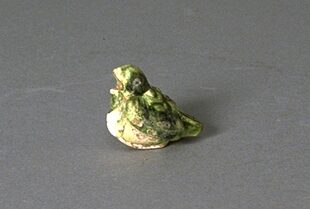Small Bird
Chinese

Description
The heads of horses, deer, mules, and other animals which represented the status or rank of the owner often decorated knives of the nomadic tribes. Such knives were often exchanged with Chinese traders at the border in the Bronze Age.
Maribeth Graybill, Senior Curator of Asian Art
Exhibited in "Flora and Fauna in Chinese Art," April 6, 2002 - December 1, 2002.
Subject Matter:
Sancai literally means three colours, but actually it’s a general term because you see examples of Sancai in which there are more than three colours. Usually these basic colours will be green, cream and amber — known as ‘egg and spinach’ in the West — but the glaze could also feature brown, blue and purple.
During the Tang dynasty (618–907 AD), Sancai wares were widely used for burial goods such as vessels and figurines. ‘On these figures you will see a lot of places that have been deliberately left unglazed,’ explains Chang. ‘Because the glaze is really runny all these different colours will mix during firing — which is not ideal for facial features. So they left the features unglazed, and later painted them in with coloured pigments. With many of the pieces we see today, the pigment is lost because it’s mostly composed of organic materials, but the glaze remains vibrant.’
https://www.christies.com/features/Glazes-A-Chinese-Ceramics-collectors-guide-7651-1.aspx
Physical Description:
A ceramic funerary sculpture in the shape of a small green sitting bird.
Usage Rights:
If you are interested in using an image for a publication, please visit https://umma.umich.edu/request-image/ for more information and to fill out the online Image Rights and Reproductions Request Form.